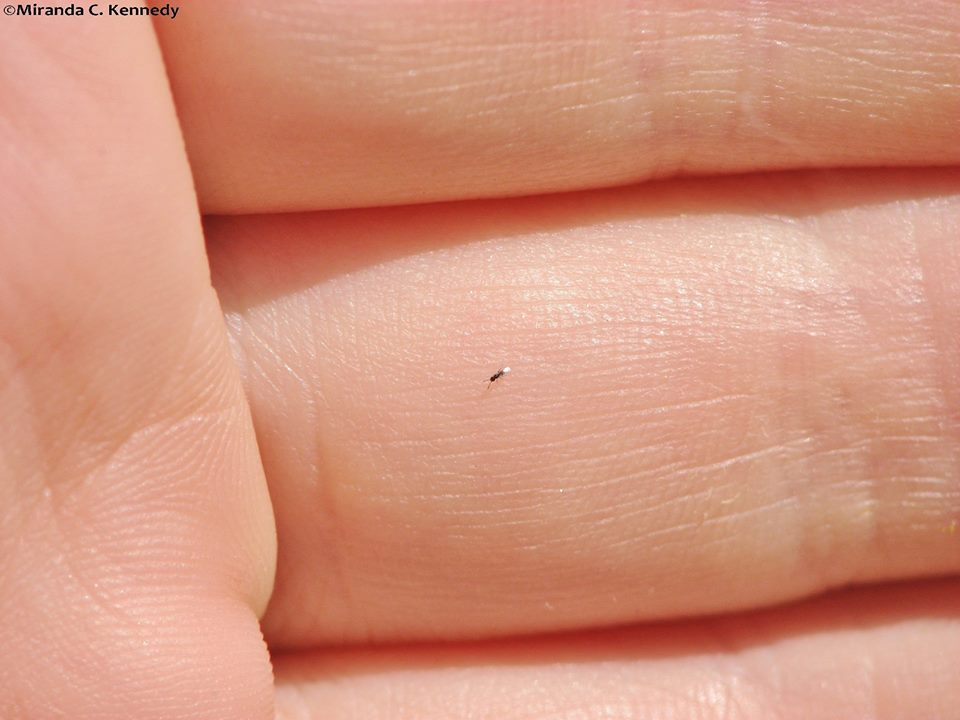Recipes
Tried and true, these are some of my favorites, and some newbies. Come eat virtually with me!
- Cob, Gardening adventures, Permaculture and Edible Forest Gardening Adventures, Soil, Vegan, Vegetables, Vegetarian
Harvesting Sweet Potatoes with Gratitude
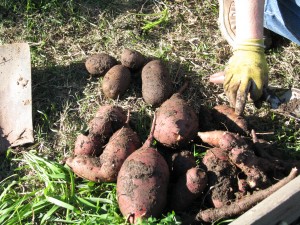
Beautiful yam harvest. I am in sensory heaven. Outside frost is again settling – a rarity here in Fallbrook, CA. Inside…. mmmm. My daughter is juicing today’s harvest of oranges. On the stove I’m poaching the last of the Harry and David pears my son sent before Christmas, in a bath of Julian apple cider (I’ve had frozen since October!), cinnamon and vanilla. There is a touch of woodsmoke from the wood burning stove. The mingled aroma of vanilla, orange and cinnamon in the air is incredible. In the fire are two homegrown potatoes in foil baking for dinner, and I’m cutting squares of homemade bread (it rained the other day… great baking and soup day!) to toast in the fire on fondue forks with mozzarella cheese and drizzled with Just Dip It (an olive oil, vinegar and herb blend from Temecula Olive Oil Co.). I am saturated with contentment and gratitude.
I wanted to write a blogpost for the first day of the year about gratitude. Instead I’m writing about harvesting yams and sweet potatoes, which, I believe, amounts to the same thing.

Tiny Russian Banana potatoes I grew in a nursery container Today the air was clean and almost 60 degrees F. Maxfield Parrish clouds filled the sky making it hard to pay attention to anything else. My daughter and I finally fired up Harry Mud, the cob oven. We experimented by baking small frozen pizzas, to success. Then in went homegrown, wrapped sweet potatoes, garlic and russet potatoes to slowly bake in the ashes. I hope I can convey sweetness of sitting outdoors on New Year’s Day eating pizza and smelling home grown potatoes and garlic cooking in a mud oven that we built, from mud from our property, as a snowy egret watched us carefully from the pond and our hens figured out how to beg. Peace. Enjoying the payoff of hard work. Eating health.
In the last few days we’ve dug up several patches of yams and sweet potatoes, the greenery of which had just been frosted black. I plant them all over the property to fill the groundcover niche of the plant guilds. I also grew some in my raised veggie beds. Some of the sweet potatoes had been small last year and so I left them in the ground. They grew.

This enormous one was six pounds! The flavor of homegrown, organic potatoes is beyond description. You don’t need sugar and marshmallows dumped on the yams; potatoes aren’t just a vehicle for toppings. I steam them, eat them with butter, salt and pepper. Phenomenal. On Christmas I roasted wedges of yams with garlic and olive oil, and not only were they terrific, the leftovers I mixed into a hash for breakfast and it was sensational.
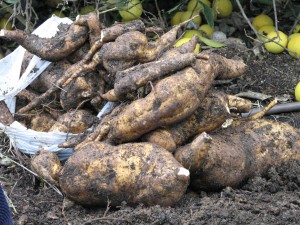
Freshly dug sweet potatoes Yams and sweet potatoes are what Americans call the orange or white tubers, respectively, sold in the grocery stores. There are actually hundreds of varieties of sweet potatoes of many colors and flavors. They are semi-tropical and like warmth. To grow, buy an organic sweet potato or yam and allow it to sprout on your counter. This is the easiest way. You may also buy slips from organic growers. Please, please don’t buy non-organic seed, slips or bulbs. Please don’t be Round-up Ready.

Colorful yams full of antioxidants. Take a sharp knife and cut slices from your sprouted yam, each containing at least one sprouted ‘eye’ , and lay them out to air dry for a couple of days in a cool, dry place out of direct sunlight. This hardens them off. Don’t plant a whole potato because the plant will have all the food it needs to produce greenery and won’t feel the need to make as many tubers. Plant the slips in well-drained soil that isn’t heavily manured; as long as water doesn’t sit around the roots, they will probably grow. I’ve had luck in many kinds of soil. The plants will spread out in a lovely, glossy-leaved groundcover that protects the soil and reduces weeds. Let the vines run and enjoy the small yam flower. Harvest in late fall, or when the greenery dies off.
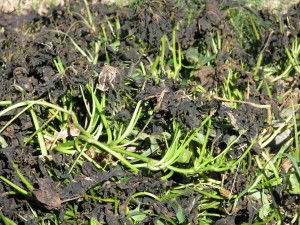
Frosted leaves of sweet potatoes Carefully dig and lift the potatoes. The skin will be more delicate than on yams store-bought. Lay the dirt-caked potatoes out to dry off before you store them in a cool dark place. Keep small slips and roots for replanting. The flavor of homegrown organic potatoes will make you wonder what the tasteless mushy things you’ve been eating have been.
This last year had its share of terrible losses, worry, pain and disappointment, along with great joy and contentment if I opened my eyes to them. They say that you reap what you sow, and as the garden and my experience deepens, and as my life mellows, I feel the truth in it. This morning we had fresh juice made of passionfruit, guava, oranges and pomegranates, all of which we grew. The potatoes, garlic, squash, greens, pickles, passionfruit curd, strawberry jam, dried tomatoes, all are at hand because of planning, sowing, nurturing, harvesting and preserving or storing. This may seem incongruous, but I am astonished at how many friends I have gained this year, through my volunteer work and exercise classes, in addition to those gained while working with County Parks, Sullivan Middle School, and the SDZoo Safari Park. So many that I wrote out the names and counted and marveled. Perhaps the list would be small for others; I don’t know, but it is wondrous and enough for me. At age 51, I have more friends and good acquaintances than I’ve ever had in my life. I am so grateful. I not only reap what I sow, but just as in my garden harvest, I have more than I could have imagined.
I do not follow a religion. In Buddhism it is said that life is a walking meditation; that every step you take is a prayer. As I put one foot in front of the other walking through the last part of my life, as I dig yams and eat them redolent with the health of good soil, as I watch those Maxfield Parrish clouds, as I laugh and work with friends who miraculously smile when they see me, I wordlessly pray my gratitude to the universe.
I very truly wish for you a year filled with gratitude and peace, and health-giving food that nourishes your heart and soul as well as your body.
- Animals, Books, Breads, Chickens, Compost, Gardening adventures, Giving, Health, Humor, Permaculture and Edible Forest Gardening Adventures, Pets, Recipes, Reptiles and Amphibians, Soil, Vegetables
The Life of Di, or Fall At My House
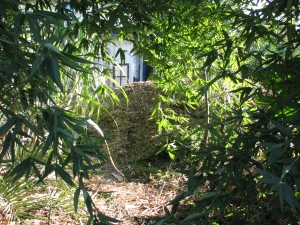
“And here’s another fine mess you’ve gotten me into!” I like to be involved with many projects at once. I picture my life as an opal, my birthstone, full of swirled colors and hues. I have several books going at once, projects chipped away at around the house, volunteer responsibilities strewn across my week, and far too many animals and acres to care for. When I’m exhausted I can spend a day on the couch reading with no trouble at all being the picture of laziness. Prior to Thanksgiving I underwent a skin cancer preventative treatment on my face and hands, which required applying a topical cream twice a day that brings suspicious cells to the surface and burns them off. By the end of the second week I was quite a mess, and then took another week to heal enough to be seen in public without alerting the zombie hunters. The treatment, needless to say, kept me from being in sunlight, therefore housebound. Always loving a clean, organized house but never actually completely cleaning or organizing, I figured I’d get some work done. I tried sorting about 15 boxes of photo albums left by my mother and grandmother… and got through one box before I had to stop. I wanted to bake bread, and I wanted to find something to do with the small amount of hops we harvested, so I experimented with a recipe that had a starter, sponge and rising that altogether took five days. The Turnipseed Sisters’ White Bread from the classic Bernard Clayton’s New Complete Book of Breads .

Turnipseed Sisters’ White Loaf starter made with hops. The starter really smelled like beer. Not in a pleasant way, either. However the bread was good, and baking was fun.

Good sandwich and toast bread. Just the extra carbs I needed for sitting on my butt for two weeks, right? Then I wanted to thin, clean and alphabetize the fiction section in my living room.

Books piled alphabetically… a little later there was a small avalanche. Yes, I have enough books in my house that they are in sections. Former school librarian and bookstore worker here. I haven’t done the non-fiction section as yet, which extends to most of the other rooms in the house. Maybe next year? I did a little writing, a lot of reading, surrounded by my elderly dog Sophie

Sophie enjoying good sleeps. who keeps returning from the brink of death to sleep about 23 hours a day, and one of my hens, Viola, who suddenly went lame in one leg.

Viola on a healing vacation. All advice was to cull her, but I thought that she pulled a muscle and hadn’t broken her leg, and being vegetarian I don’t eat my pets. Viola has been recuperating in a cage in the dining room, gaining strength in that leg, laying regular eggs, having full rein of the front yard, and crooning wonderfully. As I count wild birds for Cornell University’s Project Feederwatch, I keep an eye on the hen. The cats ignore her, thank goodness. I’ve quite enjoyed having a chicken in the house. Yep, I’m starting to be one of those kinds of aging ladies.
In between I’d spend time crawling under bushes to push and shove my 100-pound African spur thigh tortoise out of his hiding spot and into the heatlamp-warmed Rubbermaid house he shuns so that he wouldn’t catch cold in the chill damp nights. I always come out victorious, with him angry and begrudgingly warm, and with me wet, muddy, hair full of sticks and hands full of scratches. Does anyone have a life like this?
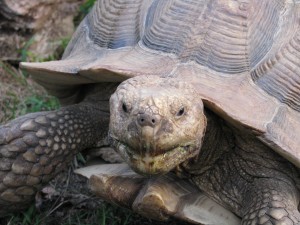
“I’m performing advanced trigonometry in my head, don’t bother me, Woman!” Finally my skin healed enough so that I was able to venture outdoors.
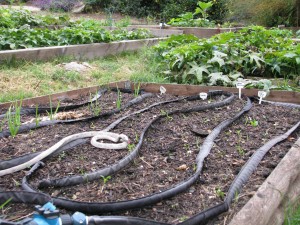
Garlic and seed sprouts guarded from birds by a rubber snake. I planted seeds of winter crops: collards, kale, garlic, onions, carrots, Brussels sprouts and broccoli rabe, and prepared raised beds for more.
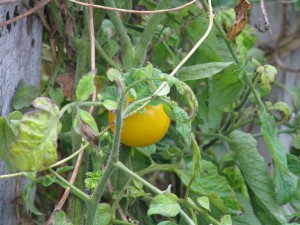
Yellow perfection tomatoes still ripening, as are the green zebra. I ordered organic pea, lupine and sweet pea seeds from Baker Creek Heirloom Seeds , all nitrogen-fixers to plant around the plant guilds.

Pepperoncini still producing. On Thanksgiving I hiked 1200 feet up Monserate Mountain in a record slow time; all that sitting and all that bread causing me to often stop and watch the slow holiday traffic on Hwy. 15, and be very glad that I was on a hike instead.
The neighbors had their annual tree butchering, paying exorbitant sums to have the same so-called landscapers come in and top their trees (shudder!) and thin others… for what reason I have no idea. Because being retired Orange County professionals they believe that trees need to be hacked back, contorted, and ruined? Possibly.
Please, please, please, friends don’t let friends top trees! Find an arborist who trims trees with an eye to their health and long-term growth and immediate beauty. A well-pruned tree is lovely, even just after pruning. A topped tree is brutal and ugly.

A topped coral tree. Ugh! Anyway, the upside is that I claimed all the chips, giving new life to the ravaged trees as mulch for my pathways. Two truckloads were delivered. I think I have enough for the whole property.
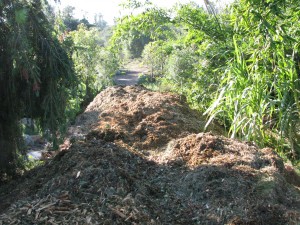
“The bear went over the mountain to see what he could see. He saw another mountain…” How to spread it? Yep, one wheelbarrow full at a time.
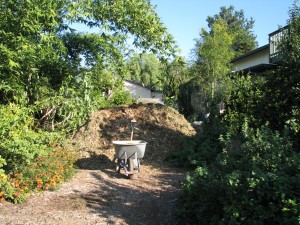
One wheelbarrow at a time. I can now condition myself for more hiking and weight lifting without leaving the property. The heaps have a lot of pine in them (they thinned the pine trees!???) so there is a pleasant Christmassy smell emanating from the heaps.
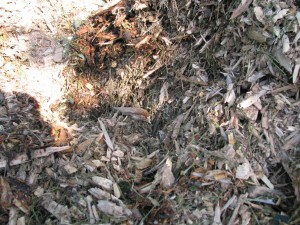
Hot steamy mulch. They are also very high nitrogen and were hot in the center on the second day and this morning were steaming right after our brief rain shower. Mulch piles can catch fire; when I worked for San Diego County Parks we rangers would joke about who had been called out by the fire department when their newly delivered mulch pile had caught fire in the night.
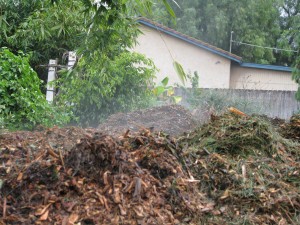
Steam from the mulch mountains. I stood on it just now and steam went up my pant legs and warmed me up! I also received a gift of seven 15-gallon nursery containers of llama poo!

The wealth of llama poo. Hot diggity! Early Christmas: My diamonds are round and brown, thank-you. I layered them in the compost heap and am ready for more.
I also wholeheartedly participated in Small Business Saturday, finding happy locals and crossing paths with friends and aquaintences at several stores. I received my first Merry Christmas from a man at Myrtle Creek Nursery’s parking lot as he waited for his son’s family to pick out a Christmas tree. I do love this town.
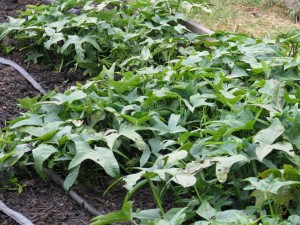
Sweet potatoes ready to harvest for Christmas dinner. That catches me up. Lots of projects, lots of volunteering, lots of cleaning up to do before my daughter comes home for the holidays and despairs at my bachelorette living. Lots of mulch to move. Lots of really great friends. Lots of sunscreen to wear. Lots to be thankful for.
-
Preserving Squash and a Terrific Pumpkin Chai Recipe!

Beautiful patterns on the banana squash shell. Four sugar baby pumpkins that I’d kept for myself, and three pink banana squash, were all in need of preservation. They were not keeping well due to the warmth of our hot San Diego county Fall. During a rainy break in the weather I did something about it. You can preserve cooked pumpkin and winter squash best by freezing it. If you have a pressure canner you may can pureed pumpkin or pumpkin pieces in liquid, but since I only use the water bath method that wasn’t an option.

Even sugar baby pumpkins can be difficult to cut when raw. There’s a better way! Roasting a squash isn’t difficult at all. In fact, you only have to wash it, put it on a tray in a 350F oven for about an hour (longer if its a really large pumpkin), and then slice when cooled.

Roasting a whole pumpkin makes the scooping so easy! Its easy to scrape out the seeds and then spoon out the cooked flesh out of the hardened shell. This is what I did for the sugar baby pumpkins. There was too much banana squash to fit whole into the oven, however, so I cut them into chunks, scooped out the seeds, covered them with aluminum foil (it helps steam them) and baked 350F for forty-five minutes.
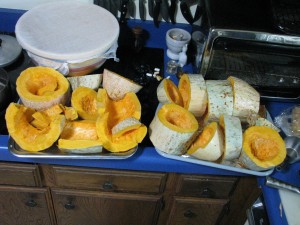
Three banana squash is a lot of squash I have more details here. I also roasted the pumpkin seeds.
Then I had a lot of squash to puree! These squash and pumpkins were dry, so I added a little water to the VitaMix and tossed in the chunks.
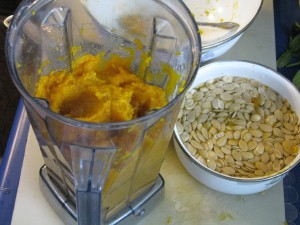
Pumpkin and seeds. I pureed batches until smooth, then spooned cups full into freezer bags. My pumpkin scone recipe calls for only half a cup, so I froze one-cup batches, as well as two-cup batches for pie. The secret to ‘vacuum-packing’ freezer bags is to close the top of the bag around a straw and then suck all the air out. It really works well, and is kind of fun, too.

Get a straw, suck out the air and presto: vacuum packed! However, the best thing that happened out of all this squashing was that I had a little less than a cup of pureed roasted squash left in the VitaMix, too little to freeze and really irritating to scoop out. It was a cold day and past lunchtime. I had an idea and spooned in what was left of some Chai tea mix, poured in vanilla soy milk, blended it until it warmed up and sat down to drink. Heaven! I’m not one for pumpkin flavored things, but this was the real deal.
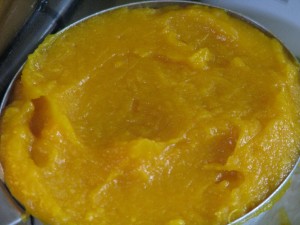
Pumpkin puree. It was so good that the next day I took a cup of the pureed squash that I refrigerated, poured in 1 1/2 cups of vanilla soy milk, a touch of orange syrup left over from candying orange peel, added cinnamon and blended until it was hot. It was thick, satisfying, a little sweet, spicy and full of beta carotene, fiber, protein and other good things. I’m sure you can do the same thing with canned pumpkin and other liquids, such as milk, rice milk, almond milk or coconut milk. If fact, I insist that you try it.

Hot Yum! Pumpkin ChaiAuthor: Diane C. KennedyRecipe type: BeverageCuisine: AmericanPrep time:Cook time:Total time:Serves: 2Cold or hot, spiced pureed pumpkin or squash mixed with the milk of your choice is extreme comfort food that is actually terrific for you!Ingredients- 1 cup cooked pumpkin or squash puree, fresh or canned.
- 1½ - 2 cups vanilla soy milk, or milk of your choice. (Less for a thick drink).
- ½ - ¾ teaspoon cinnamon, pumpkin pie spice or up to 1 scoop Chai tea mix.
- Sweetener (optional); a natural syrup would do or honey.
- ½ teaspoon vanilla (optional)
Instructions- For cold pumpkin chai mix all ingredients briefly in a blender or VitaMix.
- Taste to adjust seasonings, thickness and sweetener, and serve.
- For hot pumpkin chai, heat milk and add to the rest of the ingredients in a blender and process. If you have a VitaMix, you can add all cold ingredients and then process until it is hot.
I’m going to make some more for me right now. - Compost, Gardening adventures, Natives, Permaculture and Edible Forest Gardening Adventures, Soil, Vegetables
Leave the Leaves

The world can be saved with leaves. Yep. No kidding. We are in a season named after leaves: Fall. When deciduous trees drop their leaves they are shutting down their systems for the winter. In warm climates native plants don’t do this, rather they shed leaves over a period of time, never turning off their ability to create food through photosynthesis. Evergreens also do this, providing shelter and food for animals no matter the weather. In cooler climates many trees go into semi-dormancy, kind of a half sleep.

Liquidamber trees provide gorgeous Fall color and lots of great leaves. They reduce the number of leaves on their branches so that their productivity reduces but doesn’t completely stop. In cold climates many trees become living works of art as their leaves turn colors before falling. Much has been made of the beautiful sight of bare branches in a winter garden. A traditional Fall activity is the raking and disposing of fallen leaves. Happy kids jumping into leaf piles. However, we need to stop thinking that bare is beautiful; at least, as far as the soil is concerned.

Plant trees that will provide you with lots of leaves. The disposal of fallen leaves should be made an environmental crime. Trees drop their leaves to protect and feed their roots, and all the microbes that aid and abet them. Those decaying leaves also protect and feed bulbs, shrubs and other overwintering plants. Ever notice how snow melts around leaves and fallen branches first? That is because they also produce warmth as they decompose, warming the soil to keep the microbes alive.

The whiteness is fungus breaking down the twig. The leaves are breaking down into rich, fragrant soil. To remove fallen leaves is to take away the tree’s food, nutrition, its disease and pest control by pest control san diego and ultimately its health. It would be as if you had stored up a cabin for the winter with healthy food and supplies, and someone came and took most of your supplies except junk food, took your blankets, your firewood and your vitamins and medicines. You’d probably survive until Spring, but you wouldn’t be very healthy, and you’d stay in a hospital and be treated with drugs to combat the illnesses and injuries you accumulated. Your health would be greatly weakened.

A young sycamore just starting its leaf accumulation. This is what leaf removal does for trees. People rake up the leaves in the Fall, then in the Spring buy fertilizer (usually chemical thanks to persuasive advertising), insecticides, foliar sprays and other junk that they don’t need, take time and effort and mess to apply, are often a human health hazard if inhaled or touched, and are expensive. None of this is necessary, if people would only do less work and stop interfering. If they would leave the leaves, plant companion plants around the trees along with natives, everyone would be healthier.

Rich avocado mulch. People rake leaves and dispose of them because the leaves come from specimen trees usually dotted around lawn areas. Lawns are unnatural. Fun, pretty, functional, but unnatural. Grass doesn’t like leaves on top because the leaves block the light. Exactly. A layer of leaves around the base of the tree will prevent invasive weeds and grasses from stealing rich topsoil.

Citrus leaves and fruit. Even in grove situations, or under fruit trees, people are determined to clear every leaf off the surface of the dirt. Notice I say dirt, not soil. The trees know what they are doing; they know what they need and dropped leaves and fruit are there on the ground for a purpose. They feed the soil and thus the tree.

Leaving vegetable vines to decompose enriches your garden beds. What can be the compromise? Allow the space under your specimen trees to be cleared of grass up to and a little beyond the drip line of the tree; further would be better. When leaves fall, rake them all under the tree, being careful not to pile them up around the trunk. Plant all the shade-loving plants and bulbs that you’d like to within that space, but include members of a plant guild: a nitrogen-fixer, a groundcover, a deep tap root that mines the soil, a mulch plant, a pollinator, etc.

A leaf haven. This old oak has a large root base. I collect the leaves off the stairs only, and they are used to charge the soil under new oaks. Children like to play under the trees? Afraid of creatures lurking in the leaves? Then leave a space for human interaction. Make a barrier with stones or decorative edging that circles a little more than the drip line of the tree, but then cuts back to the trunk to leave a large wedge shape. Leave the leaves and fruit within the barrier, and keep the wedge clear for sitting and playing.

California peppers are one of many trees that drop leaves which emit a chemical that discourages competition from other plants. Still too many leaves? In their natural settings deciduous trees produce leaves enough to cover their roots and also the space between trees, which protects the fungal passageways that connect the tree roots. With a specimen tree that isn’t happening. What to do? Compost! Build an inexpensive bin with wire or pallets and cram the leaves in. Each leaf is a vitamin pill for your garden. Go in with your leaf-burdoned neighbors on the rental of a shredder and shred everyone’s extra leaves. Mulch all your garden beds and your lawn with shredded leaves. They will break down faster, heat up more quickly in a compost heap and take up less space. Your soil will turn into rich, fragrant loam.

Pine needles are high in acid; great to even out alkaline soils. Stilltoo many leaves? Post ‘free clean leaves’ on Craigslist or on your community bulletin board. Gardeners crave leaves, and may even come out to rake them up for themselves.

I only wish the leaves were this deep! The broom is just worn to a nub. Please, please don’t send your excess leaves to the landfill. The soil desperately needs those leaves and with them you won’t have to resort to chemical fertilizers, chemical sprays, high expenses and heavy labor in the Spring. You can instead spend the time watching your garden thrive.
-
Protecting Fruit

Strange fruit. We have many young fruit trees, including three figs. We have a Black Mission, a white and a Strawberry Jam fig. The trees are a year in the ground and not quite head-height, but all produce small amounts of fruit which ripen sequentially.
The birds know about the figs.
I’m glad to share a percentage of my crops with wildlife; this is a habitat after all, and there is more than enough for me and for sharing. However, there aren’t a lot of figs to go around. My daughter while home from University this summer took on a competitive attitude when harvesting the figs. She was out early testing for perfect ripeness, testing again as the sun set, being foiled by pecked fruit when it was at its peak of perfection.
Netting trees is not a good idea. The netting sits on the trees and the birds sit on it and peck through. Meanwhile it snags and sticks on the trees and is almost impossible to remove without doing damage to the trees. Also that plastic or nylon netting, if left on the ground, will often be deadly to beneficial snakes which become entangled in it (read about how I released one here).

Miranda came up with a wonderful, easy solution that re-purposed something of which we had plenty: plastic berry baskets. These baskets were hard enough to form a space around the fruit so that a bird couldn’t get its beak down through it. They also allowed air to flow around the fruit and sunshine in to ripen. They were also incredibly easy to quickly twist-tie onto the branch around an almost-ripened fig, and reposition to the next fig when it was time to pick the first one. The long twist-ties often used to hold heads of lettuces together worked best. Extra baskets were handy to put the picked figs into as well. This solution could be used for small grape clusters as well.

Obviously this solution is for small trees; but then, when the tree is large it will be producing plenty of fruit to share with the birds. Or, we can get a ladder and a lot of berry baskets and twist-ties.
That, however, may just cause talk in the neighborhood.
-
Jujube: a wonder tree

A handsome fruit. We mostly know the word jujube from having snacks as a kid in the movie theatre. Jujubes were once unchewable resinous candies of many flavors, and then were changed to something akin to gummy bears. Jujubes are a general term for a variety of candies in many countries. Oddly enough, and for reasons I know not, there is a tree called a jujube that bears wonderful fruit.

Jujube tree with fruit (a drupe, actually) ready to pick. Jujube trees (Ziziphus jujuba) have been cultivated in China for over four thousand years, and are gradually catching on in other countries. The first jujube fruit I ate was last year in a dried form. It was good, faintly reminiscent of a date. Now I have a tree that has just begun to bear fruit, and I am in love with it. The fruit is small, like very large olives. They begin green and then quickly turn to a reddish brown color, usually in blotches of color.

The fruit turns brown in patches, but can be eaten before completely dark. You can eat them fresh; in fact, I haven’t had them cooked yet. They are delightful. There is a center stone, such as in a date, but it holds two seeds.

Thin skin, crisp flesh like a green apple with a hint of date. The skin is thin and tender. The flesh is crisp and reminiscent of a green apple with hints of date. I love them. Many wait until the skin begins to wrinkle to eat them. You may pick the jujubes as they start turning color and they ripen quickly in the house without loss of flavor, or let them dry on the tree. Jujubes are high in vitamin C, and have been used medicinally in other countries, especially as a tea for sore throat. Best of all, so far the local birds ignore them, and there don’t seem to be any insect pests that love them.

Jujubes are a lovely reddish brown when ripe, and darken as they wrinkle. What makes the jujube a wonder tree is that it doesn’t seem to mind intense heat; in fact, it loves full sunshine and dry conditions. It also can survive a chill factor down to -28 degrees F! It doesn’t mind clay or alkaline soils, although good drainage and regular watering insures a good crop. They require little or no fertilization. There are many cultivars, the best being from China and more inferior ones from India and Japan. Many are thorny but some are virtually thornless. The trees can grow 30 feet high, have an attractive drooping appearance and are deciduous, the leaves yellowing before dropping. Suckers can appear several feet away from the trunk and can be controlled by mowing or pruning. You can read more about this remarkable tree here.
Why not try a jujube tree? They provide food, windbreak, mulch and have a very hard wood, and take just about any conditions. And the next time you go to a movie theatre you can bring your own jujubes… dried!
-
When Is Tuna Fish Not Tuna Fish?
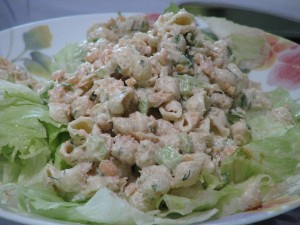
No-kill “tuna” salad! Prior to being a vegetarian, many years ago, I did enjoy a tuna sandwich or salad now and then. A perfect dish for a hot afternoon. During my almost twenty years of vegetarianism I’ve sampled many tuna substitutes, with various results. Most of them were discontinued, or were imported to a store on the East coast and then resold and shipped. Have you ever noticed how foods that are marketed as substitutes for other foods either have quotations around their names as if someone was whispering it behind their hand? Or else the names are spelled wrong, like Tuno or Bakon. There is also the saner although still questionable method of placing the word ‘mock’ in front of the word, such as ‘mock-tuna’, which is better than misspelling. Anyway, back to the topic, in trying to keep my carbon footprint low I’m eliminating the purchase of goods that require so much shipping.
This week I discovered a marvelous tuna substitute (I say, “discovered” when really I’m probably the last to know). It is low calorie, high in protein and fiber, inexpensive, easy to prepare, doesn’t kill tuna or dolphins, and they grow here in California. I can also buy them organic. They are garbanzo beans, otherwise known as chickpeas.
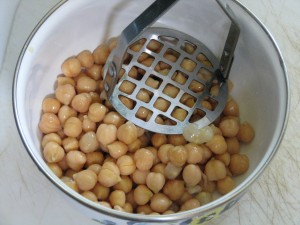
Mash garbanzos (what a great name for a bean!) until they are almost smooth. The flavor of garbanzo beans is very mild and takes well to light seasoning. Substitute mashed garbanzo beans in your favorite tuna salad or sandwich recipe. If you use Veganase – a dairy-free mayonnaise substitute – then you have a mock tuna salad or sandwich that won’t be dangerous to eat at picnics because neither the beans nor Veganase spoil quickly. Incorporating dill into the mix gives the mix a fishier flavor, since dill is so commonly paired with fish. Simple, nutritious, inexpensive and very yummy. Can’t go wrong with that!
Mock Tuna SaladAuthor: Diane C. KennedyRecipe type: EntreePrep time:Total time:Serves: 2-4A high-protein and fiber, low-cost tasty tuna substitute without any trace of mercury or dolphin!Ingredients- One can organic garbanzo beans
- 2-3 tablespoons Veganase or mayonnaise
- 1 teaspoon minced dill, preferably fresh
- 2 stalks celery, chopped
- 2 -3 cups cooked, cooled small shaped pasta, such as shells
- ¼ teaspoon ground cumin
- Salt and pepper to taste
- Chilled iceberg lettuce
Instructions- Drain and empty canned garbanzos into a small bowl.
- Mash with a potato masher until almost smooth, keeping some of the lumps for texture.
- Stir in Veganase, dill, celery, cumin, salt and pepper.
- Stir chickpea mixture into cooled noodles until well mixed.
- Serve over iceberg lettuce with a dill pickle on the side.
-
Caramel Ganache Shortbread Bars
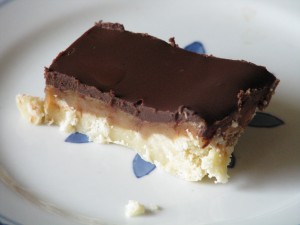 Just because I don’t post as often as I ought to, doesn’t mean that I’m not always preparing for posts. I take lots of photos, look up lots of data and try lots of recipes. Many recipes are researched, tweaked, photographed, made and turn out… icky. For instance, the no-bake cookies of last week that were only firm enough to cut at refrigerator temperature. At room temperature they turned into a pan of chocolate sludge, and at freezer temperatures they were too hard to cut. I have found, to my dismay, that many food bloggers post recipes even if they don’t turn out well, just so that they have something to post. I’m learning to read and heed the disclaimers.
Just because I don’t post as often as I ought to, doesn’t mean that I’m not always preparing for posts. I take lots of photos, look up lots of data and try lots of recipes. Many recipes are researched, tweaked, photographed, made and turn out… icky. For instance, the no-bake cookies of last week that were only firm enough to cut at refrigerator temperature. At room temperature they turned into a pan of chocolate sludge, and at freezer temperatures they were too hard to cut. I have found, to my dismay, that many food bloggers post recipes even if they don’t turn out well, just so that they have something to post. I’m learning to read and heed the disclaimers.The recipe I’m about to impart to you is not a fluke. It is, frankly, heavenly.
At a baby shower a few months ago I ate a bar cookie that was supposed to taste like a Twix candy bar. It was very good with its layers of shortbread, caramel and chocolate. I asked for the recipe and reproduced it at home. The recipe called for crushed pre-made cookies (the Keebler elves had made them, apparently) topped with melted caramel candies (unwrapping all those little buggers took time), and spread with melted milk chocolate chips. The result was tasty, but I couldn’t get over the store-bought flavor of the shortbread. This cookie has three simple flavors that need to complement each other, and since I don’t usually eat store-bought baked goods, it took some adjustment for my palate. However, they froze very well and defrosted quickly.
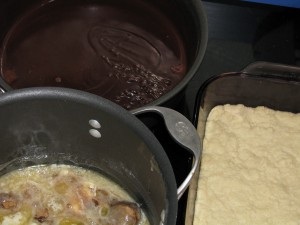
Ganache, baked shortbread and caramel mixture beginning to boil. Then I found a better recipe. And then I made it perfect. It is a basic shortbread cookie crust, topped with a simple homemade caramel, then topped with chocolate ganache. The driving impetus for this improvement was that I had leftover heavy cream in the fridge from making homemade ice cream, and needed to use it before it went bad. The ganache topping adds a bright, lighter flavor which keeps the cookie from being cloying. Yum.
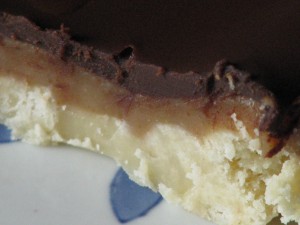
Eat a small piece with some hot tea and be very, very happy.
Caramel Ganache Shortbread BarsAuthor: Diane C. KennedyRecipe type: DessertPrep time:Cook time:Total time:Serves: 16Chocolate ganache atop firm homemade caramel and buttery shortbread. What else is there to say besides it is quick and easier than you may think.Ingredients- For shortbread:
- ⅔ cup butter, softened
- ¼ cup granulated sugar
- 1¼ cups all-purpose flour
- For ganache:
- 1 cup heavy cream
- 4 tablespoons unsalted butter
- 8 oz. semi-sweet or milk chocolate, in small pieces
- For caramel:
- ½ cup unsalted butter
- ½ cup packed light brown sugar
- 2 tablespoons light corn syrup
- ½ cup sweetened condensed milk
Instructions- Preheat oven to 350 degrees F.
- In a medium-sized bowl, mix together the ⅔ cup butter, granulated sugar and flour until crumbly.
- Press the sandy shortbread mixture into a 9-inch square baking pan.
- Bake for 20 minutes or until shortbread begins to lightly brown around edges.
- Meanwhile make the ganache. In a small saucepan combine heavy cream and 4 tablespoons butter.
- Bring mixture to a simmer.
- Turn off heat and add chocolate, swirling to cover all the bits.
- Cover pan and let sit for about 5 minutes until chocolate is melted.
- Stir until smooth and creamy and set aside (don't refrigerate).
- In a 2-quart saucepan, combine ½ cup butter, brown sugar, corn syrup and sweetened condensed milk.
- Bring to a boil and continue to boil for five minutes.
- Remove from heat and beat quickly with a wooden spoon for about 3 minutes.
- Pour caramel over baked crust (warm or cold).
- Cool until caramel begins to firm, or chill.
- Pour ganache evenly over firm caramel.
- Cover dish with plastic wrap and chill completely in refrigerator until very firm.
-
Two Sure-fire Zucchini Recipes
Zucchini plants are like cats: They both look harmless when small, so you think the more the merrier. One plant is always enough, but it is hard to plant just one seed in case it doesn’t come up. Then the sprouts are hard to thin.. what if something eats it? Then before you know it, there are five enormous plants growing giant green clubs in the dead of night, just after you’ve checked all the plants. Well, that’s my situation anyway. Too many cats; too many zucchinis. When there are enough all at one time, we’re taking them (the zucchinis, not the cats) to the Fallbrook Food Pantry along with pumpkins and tomatoes. Until then, we’re exploring new ways to eat them. And I refuse to sully cheesecake with zucchini! (yes, there is such a recipe!).
My son who is studying Culinary Arts at the University of Hawaii sent me a link to smittenkitchen.com with an exceptional zucchini pancake recipe… not sweet, very light and completely tasty. I’ll include my version. But first I want to explain my ‘discovery’, which everyone but me probably knows about anyway.
SAUTEED ZUCCHINI
I had grated zucchini for bread and had some left over. It was dinnertime and I was alone, so I experimented. I heated a skillet with a little olive oil in it, threw in the grated, undrained zucchini, and stirred it around on medium-high heat for about five minutes. When it was beginning to wilt and brown a little on the bottom, I sprinkled sesame oil on it lightly, and then gave it a touch of Bragg’s Amino Acids, which I use for many things. A light soy sauce may substitute, but Bragg’s is high in nutrition, low in salt and a wonderful flavoring. Buy it online or in health food stores. The zucchini came out tasty and with a mouth-feel of wet wide noodles. It was fantastic. I’ve since made it for my daughter a couple of times, and each time we wanted more! Imagine that! On the plus side, it used up a medium zucchini.
You really must give these pancakes a try.
Fabulous Zucchini PancakesAuthor: Diane C. Kennedy (adapted from smittenkitchen.com)Recipe type: BreakfastPrep time:Cook time:Total time:Serves: 4A light, flavorful, really good pancake that uses up a lot of zucchini and tastes like zucchini bread.Ingredients- 2 large eggs
- 3 tablespoons olive oil
- 2 tablespoons sugar (optional)
- ¼ cup buttermilk or soured milk
- ½ teaspoon vanilla extract
- 2 cups shredded zucchini
- 1 cup all-purpose flour
- ¼ teaspoon table salt
- 1 teaspoon baking soda
- 1 teaspoon ground cinnamon
- ⅛ teaspoon ground or freshly grated nutmeg
- ¼ cup semi-sweet chocolate chips (optional)
- Oil, for coating skillet
Instructions- In a large bowl whisk eggs, olive oil, sugar, buttermilk and vanilla until smooth.
- Stir in zucchini.
- In a smaller bowl, combine flour, salt, baking soda, cinnamon and nutmeg.
- Stir dry ingredients into zucchini batter, mixing until just combined.
- Stir in chocolate chips.
- Heat oil or butter in a large, heavy skillet over medium heat.
- Scoop ¼-cup rounds of batter in pan so they do not touch.
- Cook until bubbles appear on the surface, about 2 to 3 minutes.
- Flip pancakes and cook another minute or two.
- Keep pancakes warm in on a tray in the oven set on low or in a toaster oven.
- Repeat with remaining batter.
- Serve warm with or without traditional pancake toppings.
- Pancakes freeze well.
- Gardening adventures, Heirloom Plants, Permaculture and Edible Forest Gardening Adventures, Vegetables, Vegetarian
Fun Vegetables

A small green zebra, not quite ripe In a past post I related how my mother had witnessed a woman staring hands-on-hips at the produce selection in a grocery store and exclaiming, “I wish they’d come up with some new vegetables!” How true is that? How many ways can you cook the limited offerings in your average supermarket produce section without going out of your mind? That’s where a trip to an ethnic grocery store can be a life-saver. Or, plant some fun new varieties in your garden.
Thanks to Baker Creek Heirloom (Organic) Seeds and their fantastic catalog, I was spoiled for choice. I also buy a lot from Botanical Interests , an organic seed company which has packets for sale in stores such as my neighborhood Joe’s Hardware. Their wildflower seed mixtures are highlights of my garden and attract birds, butterflies and other insects. Here are some newbies I tried this year, and the keepers:
Zucchino Rampicante : an heirloom zucchini that grows on a vine. This squash grows curled or straight on long vines that need support. The fresh squash can be used like zucchini, but are firmer and have a mild butternut flavor that goes well with everything. I am completely in love with the taste of these.
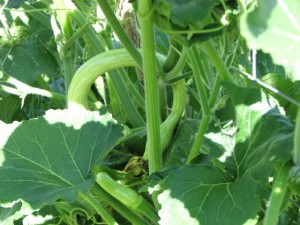
Some zucchinos are straight, some follow their own tune PLUS: if you leave the squash on the vine, it grows huge and unlike those monsterous zucchini clubs that are practically inedible and unwanted, zucchino then hardens and you can store it and use it as a winter squash! How marvelous and unwasteful is that! Zucchini without the pressure. No more alienating your neighbors and friends with excess squash.
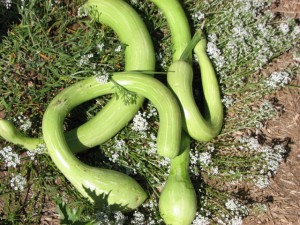
Zucchino shapes are marvelous Green Zebra Tomato :a large, lime-green striped tomato that develops a slight yellowish tinge between the stripes when ripe. These gorgeous tomatoes are rich and slightly tart, but without heavy acid. Marvelous on a open-faced sandwich or in a caprese salad to show off the color inside.
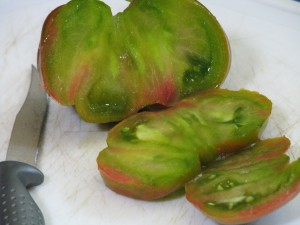
Green Zebra: beautiful inside Thai #2 Red Seeded Long Bean: The seeds were given to me by the woman who introduced me to Baker Creek Seeds, and who built my chicken and quail coops. I planted the seeds by stakes that turned out to be too short for the vines.
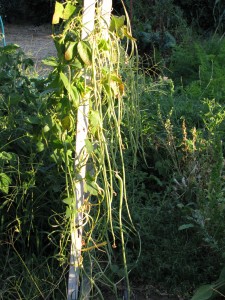
Long beans growing very long. However, these beautiful flowers eventually came, followed by spectacularly long thin green beans two feet long! One bean per person! (Just about, anyway). They are good stir-fried. I haven’t tried to tempura one yet, but its tempting.

Six long beans slice up to a serving for two! Mortgage Lifter Tomato : Now THESE are the ultimate sandwich tomato. These heavy pink-red fruits have mostly meaty insides and have an incredible savory flavor. I have found my favorite red tomato. Beefstake has nothing on this baby. It also has a cool name.
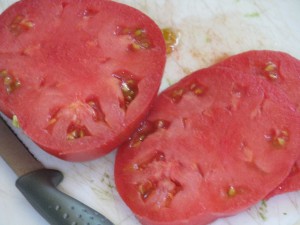
Mortgage Lifter is very meaty and savory 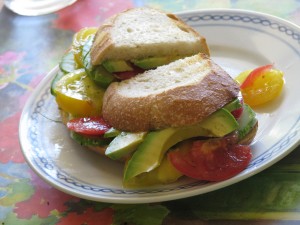
Rice Blue Bonnet: the jury is still out on this one. This is a dry-land rice. I didn’t thin it when I should have, so it is growing in clumps and hasn’t progressed beyond the thin leaves. My fault. It is growing and would probably be successful if I handle it right.
Basil Custom Blend HEIRLOOM Seeds : I planted a row and have regular and purple basil, lime basil, and cinnamon basil (one of my favorite scents). Today I used the regular and purple chopped over an open-faced tomato sandwich, and my daughter added leaves from the other two to a fruit salad.
Sesame, Light Seeded : Beautifully flowered plants with seed pods full of sesame seeds! How great is that?
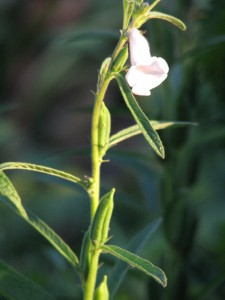
Sesame pods. Broad Windsor Fava Bean : I planted a lot of legumes to help build the soil (they set nitrogen), and tried fava beans this year. They grow like crazy, take a lot of neglect, and produce a fantastic protein source in the form of a tasty bean. They are a little trouble to shell, but well worth it. I wrote about favas here.
Blue Potatoes: These I started several years ago from an organic blue potato I bought at a grocery store. Since there are usually some small tubers left in the soil, I have volunteers sprouting every year. These blue potatoes – whatever their true variety is – are a lovely purplish blue outside, with a lovely purple center as well. They aren’t starchy, but are best used like red potatoes. Very fun.
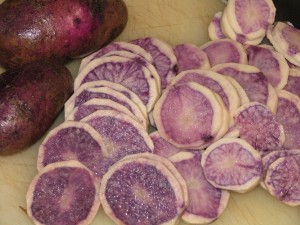
Peeled purple potatoes
